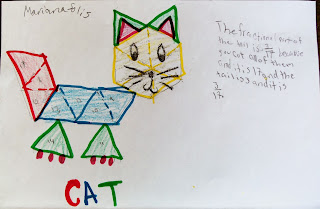3.G.A.2 Partition shapes into parts with equal areas. Express the area of each part as a unit fraction of the whole. For example, partition a shape into 4 parts with equal area, and describe the area of each part as 1/4 of the area of the shape.
4.NF.A.1 Explain why a fraction a/b is equivalent to a fraction (n x a)(n x b) by using visual fraction models....
To introduce the lesson, I showed the children a few shapes and asked them to determine the fractional value of the green blocks (or red, blue, or yellow blocks) in each figure.
Jason says, "This is 1/8 and there are 3 of them in the red part, so red is 3/8 of this shape."

I also gave the shapes interesting names to help engage the children. For example, this one is called Flaming Magic Crystal. The name alone can create a magical excitement in the classroom that sparks their interest and desire to solve the problem....."What fractional part of the crystal is blue?"

Together we solved the cat problem to determine the value of its red tail. Then the children had fun creating a second original shape, and sharing their mystery puzzles with the class.
Mariana says, "The fractional part of the tail is 3/17 because you cut all of them and it is 17 and the tail is 3 and it is 3/17."
The biggest challenge for me is to get the children to clearly write their understandings on paper. I need to continue to develop writing confidence and convince them that nothing is too obvious to communicate to others.

Angie shows her Dancing Girl puzzle.
This introduces the concept of simplifying fractions, because the girl can be broken down into 16 equal parts using the green triangles.
Yellow = 6/16 or 3/8
Blue = 4/16 or 1/4
Red = 3/16
Green = 3/16
Total = 16/16 or 1 whole
The students trace their shapes on blank white paper to record their work and prove the fractional relationships of the blocks.

Next, they decide what color they want to select for their fractional part of the whole.

Angie chooses to find the fractional part of the yellow in her design.

She realizes that the shape can be divided into 38 equal parts by using green blocks.
Next, I help her see that the yellow center is the same area as 6 of 19 total blue blocks, because 12/38 = 6/19.

Michelle tries to determine the value of the green in her clown design. Don't give up, you can do it!

Patricio wrote, "The fractional part of the green is 1/10. I know this because when I cut Donatello in green blocks it comes to 20 green blocks, but then feet are the only original green blocks, so is 2 divided by 20, or 2/20 when you simplyfy it equals to 1/10."

Alexis connected with the idea of my Flaming Magic Crystal, and created the character of Prince Vegeta from Dragon Ball Z. This creativity engages even the most reluctant math students!
Alexis wrote, "The fraction of Vegeta's Hair is 10/17 because blues is the 10 and then then the rest is the total of all the triangles."
Mariana wrote, "The fractional part of the yellow is 6/42 because their is 6 blocks in one shape and there is 42 blocks in total."
I asked if she could simplify 6/42 by finding the 7 equal parts of her flower.
Cristal wrote, "It is 12/22 because there are 22 parts of the heart and 12 parts of the yellow and when you simplife it is 6/11."
Hopefully Core Math computer testing will be merciful with spelling!!
Jason wrote, "The fractional part of the center is 6/12 = 1/2 because if you cut it in 6ths I'll be 1/2."
He is not really cutting the Star of David into 6ths. He is referring to 12 green blocks, each of which is 1/6 of a yellow pattern block. The idea of the whole changing is a difficult concept for my students.
Jessi wrote, "The fractional part is 8/12 of the body, because I made the the fish green blocks."
Next, I will show him that he can cover this same area with 4 blue blocks. So 8 of the 12 green blocks is the same area as 4 of 6 blue blocks--or 2/3 of the entire fish. Therefore, 8/12 = 4/6 = 2/3.

























No comments:
Post a Comment